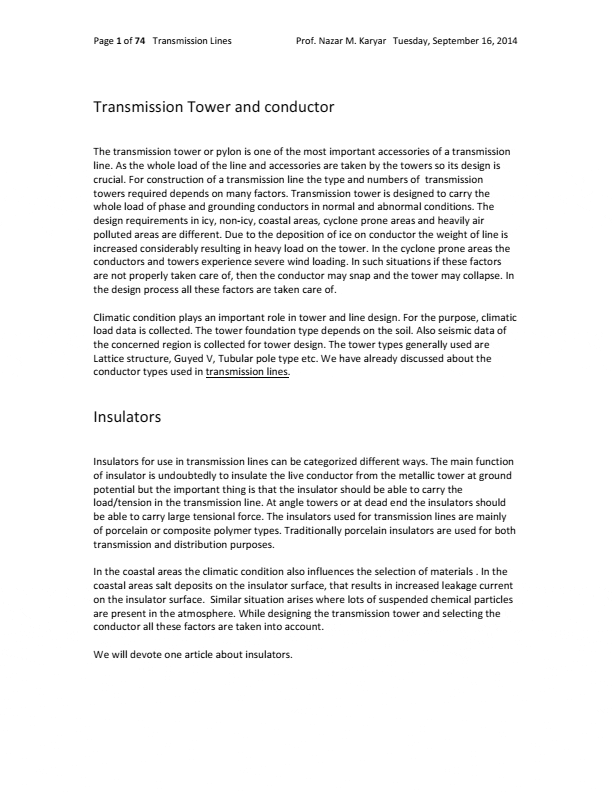Transmission substation
Let’s discuss the main factors influencing selection of substation. The discussion is mainly for transmission substation which requires many factors to be considered before selecting the site, size etc. The smaller or distribution substation has fewer requirements so only some of the points are required to be considered.

A substation is like a junction point in a power system. Many transmission lines at different voltage levels terminate at a substation. Shutdown of the substation means shutdown of all the lines terminating at the substation. Clearly a substation is a very important unit of power system.
A transmission substation may be comprised of one or more of the following main sections depending on its size and importance. These are Switchyards, Control rooms, Office building and Colony for employees.
The substation planning requires several factors to be considered. A substation which is not properly planned or designed may face several
problems, in particular if future expansion or renovation of the switchyard is required.
There are several factors that need to be considered for deciding for a substation. Some of these requirements are actually the purpose of the substation while the others are the requirements to fulfill the purpose.
Some important primary factors in the design of substation are operational flexibility, supply reliability, security and short-circuit withstand capability etc.
One important factor to be considered first is the site selection. Substation design and some equipment selection depends on site selection. Hence it has a bigger influence on the cost of substation. The orientation of the lines to be terminated at the substation also decides the
substation orientation and equipment arrangement.
The site should be near the load center keeping in view the future load growth.

Some general factors to be considered are listed. It should be remembered that some of the factors are actually interdependent:
- Access road to the site for smooth movement of construction machines, equipments and transformers. Good Roadways to construction site and shorter distance to rail head are desired.
- The site should be chosen to avoid soil filling, earth removal etc. The requirement of soil filling and earth removal takes time and increases total cost of substation.
- Historical data of worst flood is taken into account to avoid water logging of the substation in case of possibility of flood. Flood plains and wetlands are avoided.
- Atmospheric conditions like salt and suspended chemical contaminants influence selection of equipments and maintenance requirements.
- Interference with communication signals. The construction company have to take permission from the appropriate authority.
- Electric and magnetic field strength are of particular concern especially for Ultra High Voltage (UHV) systems at 765 kV,1200 kV or above.Research organisations has shown the impact of strong Electric/magnetic fields due to UHV substations and lines on human health. Such new concerns are also required to be addressed properly.
- Forest land, sanctuaries and national parks are avoided. Almost all governments has laid stringent rules to comply for approval of forest land and wild life sanctuary. The usual process takes time to get approval from the concerned authorities. This process delays the construction activities.
- Approval is also required from aviation authority. Substation should be away from airport and defence establishments.
- Water supply and sewage system are the two most important facilities to be given due consideration.
Some other factors related to the general public:
- The substation should be located far from the crowded places. Efforts are always made to locate transmission substations outside the city areas.
- The locals should be made aware of the upcoming substation. To avoid public resentment it is better to involve the local people in the process. If required they should be educated and trained. Many times the local people also plays an important role to check vandalism and theft.
- Heritage sites and tourist spots are avoided.
- Electric substation is a source of noise. While charged transformers, reactors and EHV lines are sources of continuous hissing noise, operation of different equipment also emit sudden noise. The design should be adopted to tackle the issues by complying to the standards set by the appropriate authority for reduction of noise pollution and avoid public resentments.
- Landscaping should be done to keep the substation out of direct view of common people.
Moreover the manufacturer instruction manuals, safety procedures and other documents for equipment and machines are to be referred.
A substation should have adequate arrangement of fire fighting system. It is the ultimate safety measure of any substation. The fire fighting system should be suitable for dealing with fire due to electrical arc.
Usually costly equipments like transformer should have Nitrogen gas or high speed water jet as fire fighting system.
| Title: | The professor’s lecture notes on HV/EHV transmission lines – Prof. Nazar M. Karyar at Kabul University, Electrical Engineering Department |
| Format: | |
| Size: | 2.0 MB |
| Pages: | 74 |
| Download: | Here 🔗 (Get Premium Membership) | Video Courses | Download Updates |



thanks so much!
Hi
What distance is considered as safe distance for residential purpose from a tower carrying 400KV HT lines?
10m